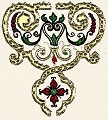|
|
 |
Costume
Quotes: Ladies
|
 |
England
1631 Private Correspondence Lady Jane Cornwallis
I have sent you some patterns of stuff such as is worne by many,
but not much laes upon those wrought stuffs; but the newest fashion
is plaine satine, of what collor one will imbroydered all over with
alcomedes, but it is not like to hould past summer. They weare sattine
wascots, plaine, rased, printed, and some imbroydered with laes,
more than any one thing and whit holland ones much.
1635. Madame, ye tailor sayeth, for gownes, either a wrought silke grogorine
or a tuffe taffety in graine, ye collor greene or tawny, which your
Ladyp. pleaseth; he requireth fourteen yardes for ye gowne, besides
the facings, of half a yarde broade.

England
1650 Artificial Changeling John Bulwer
The upstart impudence and innovation of naked breasts, and cutting
or hallowing downe the neck of womens garments below their shoulders,
an exorbitant and shamefull enormity and habit, much worn by our
semi-Adamits, is another mere peice of refined Barbarisme... Another
foolish affection there is in young Virgins, though grown big enough
to be wiser, but that they are led blind-fold by custome to a fashion
pernitious beyond imagination; who thinking a Slender-Waste a great
beauty, strive all that they possibly can by streight-lacing themselves,
to attain unto a wand-like smalnesse of Waste, never thinking themselves
fine enough untill they can span their Waste.

England
1659-1668 Diary Samuel Pepys
1659-1660. Aug. 30. This the first day that ever I saw my
wife wear black patches since we were married.
1660-1661. March 24. Comes La Belle Pierce to see my wife,
and to bring her a pair of perruques of hair as the fashion now
is for ladies to wear; which are pretty, and are of my wife's own
hair, or else I should not endure them.
April 15. With my wife, by coach, to the New Exchange, to
buy her some things; where we sawe some new-fashion petty-coats
of sarcenett, with a broad lace printed round the bottom and before,
very handsome, and my wife had a mind to one of them.
June 2. This day, my wife put on her slashed wastecoate,
which is very pretty.
June 25. She by my Lady's advice desires a new petticoat
of the new silk striped stuff very pretty. So I went to Pater Noster
Row presently, and bought her a very fine rich one - the best I
did see there, and much better than she desires or expects.
June 29. (Lord's day). To church with my wife, who this day
put on her green petticoate of flowered satten, with fine white
and black gimp lace on her own putting on, which is very pretty.
1663-1664. April 10. (Lord's day). She had put on her new
best gown, which indeed is very fine now with the lace; and this
morning her tailor brought home her other new-laced silk gown with
the smaller lace, and new petticoat I bought the other day: both
very pretty.
1665-1666. April 28. She was also to look after a necklace
of pearl, which she is mighty busy about, I being contented to lay
out 80 pounds in one for her.
April 30. My wife comes home by and by, and hath pitched
upon a necklace with three rows, which is a very good one, and 80
pounds is the price.
June 11. Walking in the galleries at White Hall, I find the
Ladies of Honour dressed in their riding garbs, with coats and doublets
with deep skirts, just, for all the world, like mine; and buttoned
their doublets up to the breast, with periwigs under their hats;
so that, only for a long petticoat dragging under their men's coats,
nobody could take them for women in any point whatever; which was
an odde sight, and a sight did not please me.
1666-1667. March 22. My wife having dressed herself in a
silly dress of a blue petticoat uppermost, and a white satin waistcoat
and white hood, though I think she did it because her gown is gone
to the tailor's, did, together with my being hungry, which always
makes me peevish, make me angry.
1667-1668. December 25. So home, and to dinner alone with
my wife, who, poor wretch! Sat undressed all day till ten at night
altering and lacing of a noble petticoat.
1668-1669. March 22. My wife this day put on first her French
gown, called a Sac, which becomes her very well, brought over
by W. Batelier.
April 12. Home, and after sitting a while, thrumming upon my viall,
and singing, I to bed, and left my wife to do something to a waistcoat
and a petticoat she is to wear tomorrow.

England
1665 The Life and Times of Anthony Wood
A strange effeminate age when men strive to imitate women in their
apparell... On the other side, women would strive to be like men,
viz., when they rode on horsback or in coaches wear plush caps lik
monteros, either full of ribbons or feathers, long periwigs which
men used to weare, and riding coate of a red colour all bedaubed
with lace which they call vests, and this habit was chiefly used
by the ladies and maids of honour belonging to the Queen, brought
in fashion about anno 1663, which they weare at this time at their
being in Oxon.

France
1670 Lettres Mme de Maintenon
You could make a robe de chambre of the grey gown I have sent you:
they are worn closed in front and widening on the shoulders: if
one wishes they can be trimmed with lace; I myself wear them plain;
sometimes if one wants to go to the expense beautiful under sleeves
are worn but many people don't have these. I have forgotten the
ribbons but you shall have them soon. Your black lace will do very
well for a winter gown.

France
1671-1676 Lettres Madame de Sévigné
1671. March 18. Madame the Duchess de Nevers came in with
her hair dressed in the most ludicruous fashion, though you know
that as a rule I like uncommon hairstyles. La Martin had had the
fancy to create a new coiffure and had cropped her! Her hair had
been cut and rolled on paper curlers which had made her suffer death
and agony a whole night long. Her head was like a little round cabbage
- nothing at the sides. My dear, it is the most ridiculous sight
you can imagine.
April 1. The hurluberlu coiffures are amusing me very
much.
April 4. I told you the other day about Mme de Nevers' new
coiffure, now La Martin is spreading the fashion... I saw yeseterday
the Duchess de Sully and the Countess de Guiche; their heads are
charming, I give in; this hair style is just what will suit you,
you will look like an angel and it is quickly done... Now just imagine
the hair parted peasant fashion to within two inches of the back
roll; the hair each side is cut in layers and made into round loose
curls which hang about an inch below the ear; it looks very young
and pretty - two bouquets of hair on each side. Don't cut your hair
too short because the curls require a lot of hair as several ladies
have found out and are example to others. Ribbons are arranged in
the usual fashion and a large curl on top which sometimes falls
down the neck. I don't know if I have explained it very well. I
shall have a doll dressed with this hair style and send it to you.
1676. November 6. Mme de Coulanges has been telling me about
transparencies: have you heard about them? They are dresses made
from the most exquisite gold and sky-blue brocade, and over this
transparent material, either beautiful English lace, or chenille
on black gauze, like the winter laces which you have seen: this
is a transparency, they can be all black, or all gold and silver,
or any colour on wishes; it is the latest fashion. This was the
dress worn at the ball on St. Hubert's day. M. le Prince has told
the ladies that their transparencies would be a thousand times more
beautiful if they would wear them next their skin.

France
End of the 1670s Mémoires Cardinal Dubois
Mme de Fontanges - let us follow our young beauty as she goes hunting
with her prince. That day she was wearing an expensively embroidered
riding habit and a hat covered with the most beautiful plumes procurable.
She looked so elegant in this costume none other could have suited
her better. As they were returning in the evening, a little breeze
blew up which obliged Mme de Fontanges to remove her hat. She tied
up her hair with a ribbon which just fell over her forehead and
the king liked this so much that he asked her to wear her hair dressed
in this fashion in the evening. The next day all the Court ladies
appeared with the same coiffure. That is the origin of the high
head-dresses that are still worn and which from France have spread
throughout all the Courts of Europe.

England
1680-1684 Manners and Customs of London J.P. Malcolm
1680. Articles stolen: A black serge gown, stiff bodied;
two large black flowered silk skirts; a white silk petticoat laced;
a mantua, lined with pink-coloured silk; a white mohair petticoat,
laced; a yellow silk net petticoat, with bone lace.
1682. A large portmantle full of women's clothes lost or stolen: A mantua
and petticoat of greysilk and silver stuff, with broad silver lace;
another mantua and petticoat, flowered with liver-coloured and some
flesh-coloured spots; a quilted petticoat of lead-coloured satin;
a gold-coloured tabby toilet and pin-cushion, with silver lace;
two point coifs, two pair of 'point d'Espagne' ruffles; a laced
night rail and waistcoat; one pair of 'point de venise' ruffles;
a black laced scarf; three black satin caps, and some little bands
and cuffs. Another parcel: A striped silk mantua; a light-coloured
gown, striped with yellow and white; a blue flowered silk petticoat;
a pair of blue striped stays; a black fresener hood, and a yellow-spotted
hood.
1684. Lost between Hackney and London: A petticoat of musk-coloured silk,
shot with silver on the righ side, the flowers trail silver, and
the wrong side the ground silver, the flowers musk-coloured, with
a deep white thread bone lace; a white fringe at the bottom, and
a gold one over it; six breadths, lined with Persian silk of the
same colour.

France
1687 Correspondence Madame, Duchesse D'Orléans
It is not surprising that you are wearing fontanges because everybody
here does from little girls seven years old to old women in their
eighties, the only dfference is that young people wear them in all
colours, whereas their elders have only black or dark-coloured ones.

England
1694 The Ladies Dictionary John Dunton
Apparel, or the Ladies Dressing-Room
A Commode, is a frame of Wire, two or three Stories high,
fitted for the Head, or cover'd with Tiffany, or other thin Silks;
being now compleated into the whole Head-dress.
An Echelles, is a Stomacher lac'd or ribbon'd in the form
of the Steps of a Ladder, lately very much in request.
Engageants are double Ruffles that fall over the wrists.
A Font-Ange, is a modish Top-knot first worn by Mademoiselle
de Fontange, one of the French King's Misses, from whom it takes
its name.
A Palatine is that which used to be called a Sable-Tippet,
but that name is changed to one that is supposed to be finer, because
newer.
A Mont la haut is a certain Wier that raises the Head-Dress
by degrees or stories.
A Spagnolet is a Gown with narrow Sleeves and Lead in them,
to keep them down. À la Spagnole.
A Sultane, is one of these new fashioned Gowns trimmed with
Buttons and Loops.
A Tour is an Artificial dress of hair, first invented by
some ladies that had lost their own hair.

France
Correspondence Madame, Duchesse D'Orléans
1695 I don't know why people have so many different styles
of dress; I only wear Court dress (le grand habit) and a
riding habit; no others; I have never worn a robe de chambre nor
a mantua, and have only one robe de nuit for getting up in the morning
and going to bed at night.
1702 At
Versailles which is considered the royal residence, everyone who
comes into the King's presence or into ours, must be in full Court
dress, but at Marly, Meudon, and Saint-Cloud, mantuas are worn,
as also for travelling. I find Court dress much more convenient
than mantuas which I can't endure.

France
1710 Mémoires sur La règne de Louis XIV Marquis de Sources
The King went again in the evening to see the Duchess de Bourgogne
whom he found resting on a couch wearing an andrienne (this
was a robe de chambre undraped and with a long train; it was named
after a dress of this style worn by an actress in the Comedy 'Andrienne').

England
1711 The Spectator
There is not so variable a thing in nature as a Lady's Head-dress:
within my own memory I have known it rise and fall above Thirty
Degrees. About ten Years ago it shot up to a very great Height,
insomuch that the Female part of our Species were much taller than
the Men. The Women were of such an enormous Stature, that we appeared
as Grass-hoppers before them: At present the whole Sex is in a Manner
dwarfed and shrunk into a Race of Beauties that seems almost another
Species... they are at present like Trees new lopped and pruned,
that will certainly sprout up and flourish with greater Heads than
before.

England
1712 The Guardian
There is a certain female ornament by some called a tucker, and
others the neck-piece, being a slip of fine linen or muslin that
used to run in a small kind of ruffle round the uppermost verge
of the women's stays, and by that means covered a great part of
the shoulders and bosom. Having thus given a definition, or rather
description of the tucker, I must take notice that our ladies have
of late thrown aside this fig-leaf, and exposed in its primitiv
nakedness that gentle swelling of the breast which it was used to
conceal.

France
1713 Mémoirs Saint-Simon
The Duke and Duchess of Shrewsbury arrived here a little while ago.
She, a large woman who once was beautiful, wore a very low-necked
bodice, her hair behind her ears, lots of rouge and patches. She
thought our ladies' headdress ridiculous, which indeed it was. It
was a structure of wire, ribbons, hair and geegaws more than two
feet high which placed the head in the middle of the body. It shook
with every movement and was extremely uncomfortable. The King, in
everything else an absolute dictator, could not endure them: they
had been worn for more than ten years and no matter what he said
or did, could not get rid of them. What the King could not achieve
was accomplished with surprising rapidity by a silly old foreigner.
After being so extremely high they then fell extremely low. These
simpler easier hair styles, which are much more becoming, are still
worn.

England
1714 The Spectator
Among the several female extravagancies I have already taken notice
of, there is one which still keeps its ground. I mean that of the
ladies who dress themselves in a hat and feather, a riding coat
and a perriwig, or at least tie up their hair in a bag of ribbon,
in imitation of the smart part of the opposite sex.

France
Journal et Mémoires Matthieu Marais
1720 At present all the ladies are cutting their hair and
only keep a few short bits at the back which they curl and call
a 'tignon'. 'Le corps en sac', which they call a sack and wear everywhere,
even in church, is a long gown undraped and buttoning in front.
'Le cul en panier', which has been worn for the last two years,
is a sort of farthingale which they put under their skirts to make
them fuller and wider round the bottom. They have taken this fashion
from Englishwomen and call it a panier.
1721 Indian cottons - a law was passed on 8 July 1721 giving the penalties against those who sell or wear cottons. Life
imprisonment for those who bring then into the country and also
for those who trade in and stock them. Banishment for the tailors,
rag-men, mantua-makers. For a second offence the galleys for the
men and perpetual banishment for the women. A fine of 3.000 liv.
for those who wear them, etc.
1723 All the ladies are again wearing robes of Indian cotton
although this has been so often prohibited; another law was passed
on the 5 July which will be again ignored in three months time.

Female
Costumes
Ladies' Baroque Clothing
Indoor
Garments | Footwear | Accessories | Hairstyles | Head-dresses | Development
of the Fontange
Hairstyles
by Vermeer | Dress
Colours by Vermeer | Head-dresses
by Vermeer
Costume Focus Headwear & Neckwear | Costume
Focus Working Women
Costume
Focus Children's Clothing
Ladies' Costume Quotes
Male
Costumes
Gentlemen's
Baroque Clothing
Indoor
Garments | Footwear | Accessories | Hairstyles | Head-dresses
Costume
Colours by Vermeer | Hair-
and Head-dresses by Vermeer
Gentlemen's
Costume Quotes
~ ~ ~ ~ ~ ~ ~ ~ ~ ~ ~ ~ ~
Embroidery Gallery | Gallery of Needlework
Engravings
Lace Gallery &
Identification | Glossary
Contents © N. Kipar 1997 |









